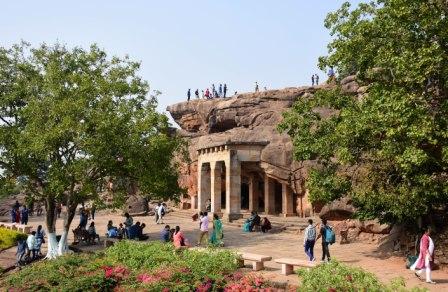Bhubaneswar: In order to attract more tourists to Khandagiri & Udaygiri caves, the state government has decided to upgrade the infrastructure of the site in the state capital.
The Tourism department has issued a tender for preparation of an integrated heritage and tourism master plan for development of Khandagiri-Udayagiri into a world-class tourist attraction with ultramodern features, amenities and attractions.
The Khandagiri-Udayagiri area is witnessing footfall of over 3 lakh tourists every year. Due to huge influx, the monument and its surroundings have been heavily damaged in recent years. Besides, the presence of active traffic in between twin hills is a major cause for concern for people. Hence, the department has decided to develop the area, sources said.
The department plans to ease the traffic near the site with inclusion of unique and innovative components like sustainable transportation, non-motorised transport and pedestrianisation among others.
It has also planned to put up unique tourism information signages and location orientation map and streetscape with roadside seats and landscaping.
The government will also find out alternate space for rehabilitation of local vendors, who have put their stalls near the tourism sites.
Meanwhile, the department has also decided to set up ropeways at various locations including Dhauli, Panchalingeswar, Kapilash and Nrusinganath.
Udayagiri and Khandagiri Caves, formerly called Kattaka Caves or Cuttack caves, are partly natural and partly artificial caves of archaeological, historical and religious importance. The caves are situated on two adjacent hills, Udayagiri and Khandagiri, mentioned as Kumari Parvata in the Hathigumpha inscription.
They have a number of finely and ornately carved caves built during the 1st century BCE. It is believed that most of these caves were carved out as residential blocks for Jaina monks during the reign of King Kharavela.
Udayagiri means “Sunrise Hill” and has 18 caves while Khandagiri has 15 caves. The caves of Udayagiri and Khandagiri, called lena or leṇa in the inscriptions, were dug out mostly during the reign of Kharavela for the abode of Jaina ascetics.
The most important of this group is Ranigumpha in Udayagiri which is a double storeyed monastery. Other important caves include Hathi gumpha, Ananta gumpha, Ganesha gumpha, Jaya Vijaya gumpha, Mancapuri gumpha, Bagha/Byaghra/Vyaghra gumpha and Sarpa gumpha.
PNN






































